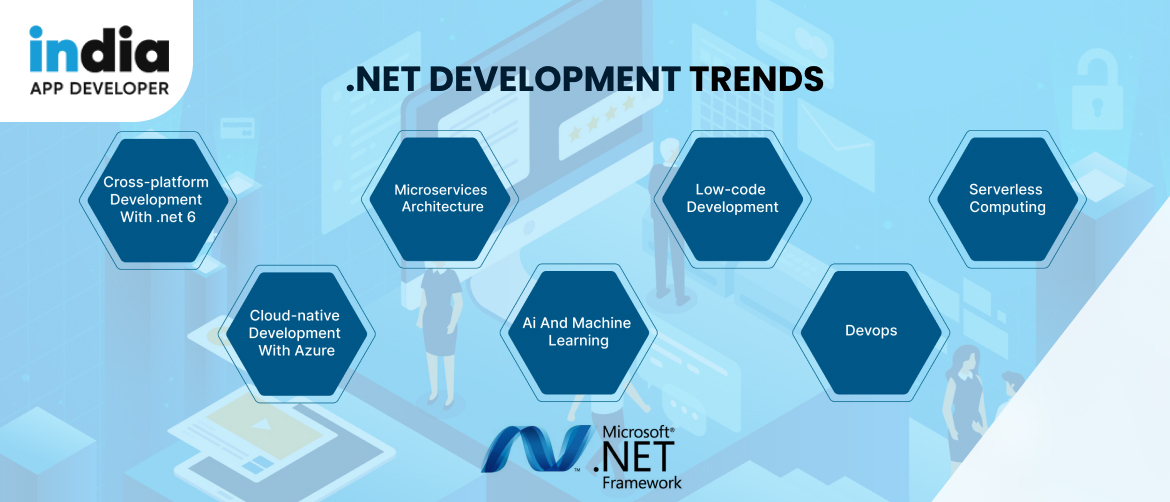Introduction
The rapid evolution of software development demands that developers stay attuned to emerging trends. Microsoft’s .NET ecosystem continues to be a cornerstone for building high-performance, scalable, and secure applications. As we step into 2025, advancements in AI integration, cloud computing, and cross-platform capabilities are poised to redefine how developers utilize .NET.
The Strategic Importance of .NET in 2025
.NET remains a premier framework due to its cross-platform compatibility, performance optimizations, and cloud-native capabilities. Whether it’s enterprise solutions, AI-driven applications, or microservices architecture, .NET provides a robust and flexible development environment.
Here’s an in-depth look at the top 7 .NET development trends shaping 2025 and their implications for developers and businesses.
1. The Emergence of .NET 9 and Future Innovations
Microsoft’s commitment to annual releases ensures that .NET 9 introduces crucial advancements:
-
Optimized runtime performance, leading to lower memory overhead and enhanced execution speed.
-
Refined cross-platform functionalities, streamlining the development of applications across Windows, macOS, and Linux.
-
AI-augmented development tools, such as intelligent code assistance and debugging automation.
-
Advanced security protocols, incorporating proactive threat detection and mitigation strategies.
Adopting .NET 9 early will empower organizations with improved efficiency, security, and development speed.
2. Blazor’s Evolution as a Web Development Powerhouse
Blazor is gaining traction as a compelling alternative to JavaScript frameworks for building interactive web applications with C#. In 2025, its adoption will be driven by:
-
Significant performance enhancements in WebAssembly-based execution.
-
Blazor Hybrid applications, simplifying the development of cross-platform desktop and mobile solutions.
-
Expanded support for Progressive Web Apps (PWAs), enabling rich user experiences within browsers.
Blazor’s growth reinforces the shift towards C#-driven full-stack development, reducing the need for JavaScript-based frameworks.
3. AI and Machine Learning Expansion in .NET
Artificial Intelligence (AI) and Machine Learning (ML) are becoming integral to modern application development. The .NET ecosystem is evolving to support these capabilities through:
-
Expanded ML.NET functionalities, facilitating streamlined model training and deployment.
-
Tighter Azure AI integration, providing developers with powerful AI-driven analytics and automation.
-
AI-assisted coding tools, including GitHub Copilot and advanced debugging solutions.
By leveraging AI and ML in .NET, organizations can build intelligent, data-driven applications that enhance automation and decision-making processes.
4. Cloud-Native and Serverless Computing with .NET
As businesses shift toward cloud-first strategies, .NET’s compatibility with major cloud providers, such as Azure, AWS, and Google Cloud, is fostering innovation through:
-
Microservices-based architecture, promoting modular and scalable application design.
-
Serverless computing solutions, reducing operational costs via Azure Functions and AWS Lambda.
-
Containerized applications, leveraging Docker and Kubernetes for streamlined deployment and orchestration.
Adopting cloud-native approaches within .NET allows businesses to enhance agility, scalability, and cost-effectiveness.
5. .NET MAUI’s Role in Cross-Platform Development
.NET Multi-platform App UI (.NET MAUI) is solidifying its place as a successor to Xamarin, enabling developers to build applications for Android, iOS, Windows, and macOS using a unified codebase. In 2025, .NET MAUI will introduce:
-
More efficient UI rendering mechanisms, improving performance and responsiveness.
-
Greater platform-specific extensibility, allowing deeper integration with native APIs.
-
An expanded ecosystem of third-party plugins, enhancing development flexibility.
By adopting .NET MAUI, organizations can accelerate development cycles while maintaining a consistent user experience across platforms.
6. Advanced Security and Compliance Measures in .NET
With cyber threats on the rise, security remains a top priority for .NET developers. The 2025 landscape sees an emphasis on:
-
Zero Trust architecture, reinforcing authentication and access control mechanisms.
-
Enhanced encryption standards, securing sensitive data against cyber threats.
-
Stringent compliance adherence, ensuring compatibility with regulations like GDPR, HIPAA, and ISO/IEC 27001.
Implementing these security enhancements is crucial for maintaining application integrity and user trust.
7. The Growth of Low-Code and No-Code Development in .NET
The rise of low-code/no-code platforms is accelerating software development, with .NET adapting to this shift by:
-
Integrating with Microsoft Power Platform, enabling rapid application prototyping.
-
Enhancing UI drag-and-drop builders, reducing dependency on manual coding.
-
Leveraging AI-driven code generation, facilitating automatic code suggestions and refactoring.
These innovations allow businesses to shorten development lifecycles and enable non-developers to participate in application creation.
Also Read:
- Hire ASP .Net Developer Guide
- Back-End & Web Development Trends for 2025
- Android App Development Trends in 2025
Conclusion
The .NET ecosystem is undergoing a transformation, fueled by advancements in AI, cloud computing, security, and cross-platform development. Staying ahead in 2025 requires embracing these cutting-edge technologies to deliver scalable, high-performance, and future-ready applications.
By proactively leveraging these .NET trends, businesses and developers can enhance productivity, drive innovation, and remain competitive in an evolving digital landscape.

























